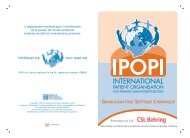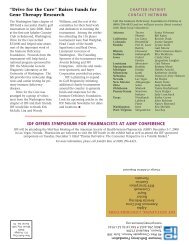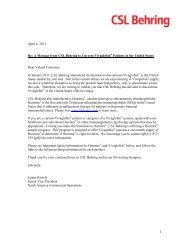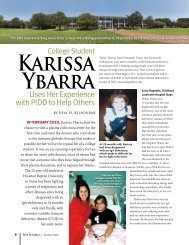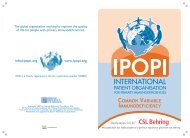IDF Patient & Family Handbook for Primary Immunodeficiency ... - IDFA
IDF Patient & Family Handbook for Primary Immunodeficiency ... - IDFA
IDF Patient & Family Handbook for Primary Immunodeficiency ... - IDFA
You also want an ePaper? Increase the reach of your titles
YUMPU automatically turns print PDFs into web optimized ePapers that Google loves.
98 Specific Medical Therapy<br />
Hematopoietic Stem Cell Transplantation continued<br />
to recognize the patient (host) as <strong>for</strong>eign, and the<br />
graft versus host reaction is markedly reduced and<br />
sometimes eliminated. Although the mature<br />
T-lymphocytes have been removed from the grafted<br />
stem cells, T-lymphocytes of donor origin can still<br />
develop from those stem cells and reconstitute the<br />
patient’s T-lymphocyte immunity. The risk of graft<br />
versus host disease from these T-lymphocytes is<br />
markedly reduced because these cells develop<br />
inside the new host from immature precursor cells<br />
in the grafted marrow. Like a person’s own T-cells,<br />
they are “educated” during their maturation to<br />
ignore or “tolerate” the histocompatibility antigens<br />
on the cells of the recipient (host). Since it takes<br />
longer <strong>for</strong> new T-cells to mature and learns to<br />
work with other cells in the recipient, engraftment<br />
from T-cell depleted HSCTs is usually slower than<br />
with matched HSCTs, and complete immunologic<br />
reconstitution may not occur. Occasionally, more<br />
than one transplant has to be per<strong>for</strong>med to help<br />
create a fully functioning new immune system in<br />
the recipient. Unmatched donors <strong>for</strong> this kind of<br />
transplant will usually be one of the recipient’s<br />
parents (called haploidentical transplants), since<br />
they share one half of the transplantation antigens<br />
of their child (see Figure 1). Some centers use<br />
this approach frequently <strong>for</strong> treatment of SCID<br />
babies while other centers believe that the search<br />
<strong>for</strong> a matched unrelated donor is the first choice<br />
option. It is also possible to do T-cell depletion in<br />
situations where less than fully matched unrelated<br />
donors are used.<br />
The Procedure of Bone Marrow<br />
Transplantation<br />
Bone marrow transplantation is accomplished by<br />
removing bone marrow from the pelvic bones.<br />
Bone marrow is removed by drawing the marrow<br />
up through a needle which is about 1/8 of an<br />
inch in diameter. Only two teaspoons are taken<br />
from each puncture site because, if more is<br />
taken, the sample is diluted with the blood which<br />
flows through the bone marrow space. Bringing<br />
blood with the bone marrow increases the risk<br />
of carrying over the mature T-cells which cause<br />
GvHD. Usually, two teaspoons are taken <strong>for</strong> each<br />
two pounds of the recipient’s body weight. The<br />
average donor might have only a few punctures<br />
per<strong>for</strong>med to get enough stem cells <strong>for</strong> a baby,<br />
but over 100 punctures may be required to<br />
get enough stem cells <strong>for</strong> a teen or full sized<br />
adult. The procedure may be per<strong>for</strong>med under<br />
general anesthesia or under spinal anesthesia.<br />
The discom<strong>for</strong>t after the procedure varies from<br />
donor to donor. Nearly everyone will require some<br />
type of pain control medication <strong>for</strong> two to three<br />
days, but most are not required to stay in the<br />
hospital overnight, and are able to return to full<br />
activity shortly. Due to the ability of stem cells to<br />
regenerate them, being a donor does not deplete<br />
or damage one’s immune system.<br />
After removal from the donor, the bone marrow is<br />
passed through a fine sieve to remove any small<br />
particles of bone and then placed in a sterile<br />
plastic bag. The cells are given to the patient with<br />
a primary immunodeficiency through a needle into<br />
a vein in the same manner as a blood transfusion.<br />
Results of Bone Marrow<br />
Transplantation<br />
Bone marrow transplantation between HLA<br />
matched siblings has been successfully employed<br />
in the treatment of immunodeficiency since 1968.<br />
The first child to receive a transplant, a patient<br />
with SCID, is still alive, healthy and has a family<br />
of his own. This case suggests that, as best as<br />
can be determined, the graft is very long lasting<br />
and appears to be permanent. In the usual<br />
patient with a primary immunodeficiency, bone<br />
marrow transplantation involving a “matched”<br />
marrow has minimal graft versus host disease<br />
and is associated with an overall success rate of<br />
as high as 90%. Many of these recipients can be<br />
considered cured and will be free from any signs<br />
of their primary immunodeficiency. However, a<br />
great deal depends on the health of the patient<br />
at the time of the transplant. If the patient is in<br />
relatively good health, free from infection at the<br />
time of the transplantation and does not have lung<br />
damage from previous infections, the outlook is<br />
very good. The chances of a successful transplant<br />
in SCID with full recovery by the recipient will be<br />
best if the transplant is done within the first month<br />
of life. Many patients who have diseases such as<br />
Wiskott-Aldrich syndrome, chronic granulomatous<br />
disease, or hyper IgM syndromes who require<br />
chemotherapy be<strong>for</strong>e the transplant to allow<br />
engraftment of the new bone marrow can also be<br />
cured by HSCT. Here again, the initial health of the<br />
patient is extremely important and the best survival<br />
is in children transplanted under the age of five<br />
who are relatively free of infections and who do not<br />
have pre-existing lung or liver damage.








